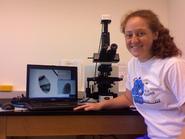
Armed with her pipette and sterile gloves, Danielle Lashley ’13 carefully transfers the solution from her test tube to the petri dishes in front of her. But the solution she so cautiously maneuvers is store-bought Juicy Juice, used to attract flies so she can work with their embryos. Lashley is attempting to clone and catalog the development of two gap genes of the common fruit fly, Drosophila melanogaster, in embryos. Lashley is being advised by Visiting Assistant Professor of Biology Danyang Yu.
As the embryo of any organism develops, special genes called transcription factors (or gap genes) inhibit or enhance the expression of different genes to cause the development of particular elements of the organism’s body. The two that Lashley is focusing on are called Hunchback and Orthodenticle, which ultimately determine the formation of the segments of the body as well as the anterior and posterior poles of the adult fly. “The intriguing part about these genes is that they exist in very distinct patterns along the embryo,” Lashley said. “These different ‘stripes’ of genes are formed and maintained by different classes of transcription factors,” of which Hunchback and Orthodenticle are two.
To track the movement and influence of these two gap genes, Lashley will stain them blue. After she collects the embryos by attracting all the flies to her dishes full of sugary Juicy Juice, she amplifies the genes using a polymerase chain reaction (PCR). She then binds probes to the mRNA of both genes (which will travel to the necessary parts of the organism) and stains the probes using a dig antibody, making them visible under a microscope no matter where they go in the embryo.
Every time she sees a new stain pattern, Lashley will snap a picture; “By the end of my time over the summer, I hope to have an atlas of pictures of all the stages of the embryo’s development stained for Hunchback and Orthodenticle,” Lashley said. These two gap genes are common in other organisms as well, and Professor Yu hopes to use the information Lashley collects to compare with other organisms so that she can eventually chart their evolutionary process.
Lashley is not new to the research process. Chosen as a member of her school’s S.M.A.R.T. (Students Modeling a Research Topic) Team early in high school, Lashley spent two years doing research and ended up isolating a previously-undiscovered bacteriophage, which she and her lab partner named after themselves. She has long wanted to do research at college-level facilities; “I am really lucky that Hamilton has given me the opportunity to be here the summer after my freshman year,” she said.
An aspiring double major in biochemistry and art, Lashley is also a resident advisor, a member of the HAVOC Executive Board and the site coordinator for the Loretto Center in Utica.
Lashley is a graduate of the Pingry School in Martinsville, N.J.
As the embryo of any organism develops, special genes called transcription factors (or gap genes) inhibit or enhance the expression of different genes to cause the development of particular elements of the organism’s body. The two that Lashley is focusing on are called Hunchback and Orthodenticle, which ultimately determine the formation of the segments of the body as well as the anterior and posterior poles of the adult fly. “The intriguing part about these genes is that they exist in very distinct patterns along the embryo,” Lashley said. “These different ‘stripes’ of genes are formed and maintained by different classes of transcription factors,” of which Hunchback and Orthodenticle are two.
To track the movement and influence of these two gap genes, Lashley will stain them blue. After she collects the embryos by attracting all the flies to her dishes full of sugary Juicy Juice, she amplifies the genes using a polymerase chain reaction (PCR). She then binds probes to the mRNA of both genes (which will travel to the necessary parts of the organism) and stains the probes using a dig antibody, making them visible under a microscope no matter where they go in the embryo.
Every time she sees a new stain pattern, Lashley will snap a picture; “By the end of my time over the summer, I hope to have an atlas of pictures of all the stages of the embryo’s development stained for Hunchback and Orthodenticle,” Lashley said. These two gap genes are common in other organisms as well, and Professor Yu hopes to use the information Lashley collects to compare with other organisms so that she can eventually chart their evolutionary process.
Lashley is not new to the research process. Chosen as a member of her school’s S.M.A.R.T. (Students Modeling a Research Topic) Team early in high school, Lashley spent two years doing research and ended up isolating a previously-undiscovered bacteriophage, which she and her lab partner named after themselves. She has long wanted to do research at college-level facilities; “I am really lucky that Hamilton has given me the opportunity to be here the summer after my freshman year,” she said.
An aspiring double major in biochemistry and art, Lashley is also a resident advisor, a member of the HAVOC Executive Board and the site coordinator for the Loretto Center in Utica.
Lashley is a graduate of the Pingry School in Martinsville, N.J.
Posted August 3, 2010
